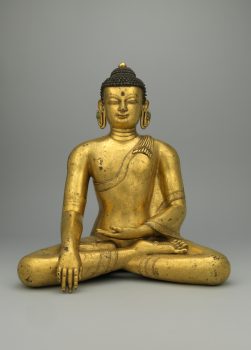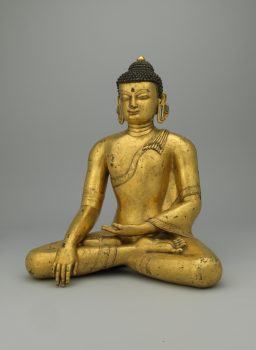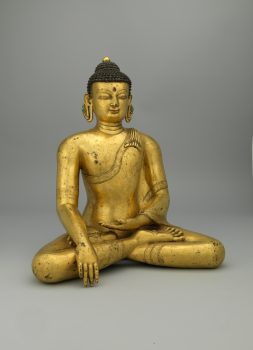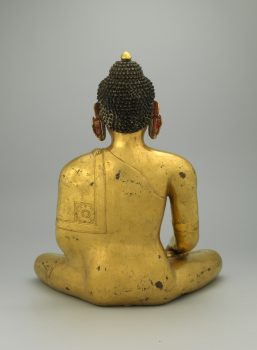Karnali Basin, Khasa Malla Kingdom, Northwestern Nepal
13th-14th century
This is the gesture of the Buddha calling the earth to witness his awakening.
Karnali Basin, Khasa Malla Kingdom, Northwestern Nepal
13th-14th century




This sculpture of the historical Buddha shows him with characteristic lotus wheel marks on his hands and feet, wearing monastic dress, and performing the gesture of touching the earth, a reference to his enlightenment.Artistic centers developed in a number of kingdoms along the Himalayan range, including the Khasa Malla kingdom of northwestern Nepal, to which this fine image of the Buddha can be attributed. The sculpture is sturdy and has a proportionally large head with a low forehead and broad shoulders. Characteristic of the Khasa Malla period are the beak-like nose and the downcast eyes widening at the sides. The details of his monastic robe, the ornamented hem across the chest and the tail end on the shoulder, are quite stylized. He wears upturned earrings inlaid with turquoise, an unusual feature of the Khasa Malla aesthetic.
A state of “waking up” from illusion and seeing the true nature of reality. Buddha Shakyamuni attained enlightenment while meditating under the bodhi tree. Buddhist teaching explains that the accumulation of merit and wisdom are essential for achieving enlightenment, also known as awakening.
A state of “waking up” from illusion and seeing the true nature of reality. Buddha Shakyamuni attained awakening while meditating under the bodhi tree. Buddhist teaching explains that the accumulation of merit and wisdom are essential for achieving awakening, also known as enlightenment.
The antidote to ignorance, with the highest form of wisdom being an understanding of the true nature of reality and all phenomena. In Buddhism studying the nature of interdependence and emptiness is considered an important step for attaining wisdom.
An awakened being who understands the true nature of reality and is free from the cycle of birth, death, and rebirth. While there are many buddhas, Siddhartha Gautama is the historical Buddha, whose teachings became the foundation of Buddhism.
The Himalayan kingdoms of the Kathmandu Valley were significant centers of Buddhist culture. Nepalese kings, Buddhist institutions, and ordinary people patronized the vibrant art guilds. The artistic traditions of the regions are well-known in Tibetan areas and beyond, and Newar artists have always been in high demand throughout Tibetan regions and Inner Asia.
Get the latest news and stories from the Rubin, plus occasional information on how to support our work.